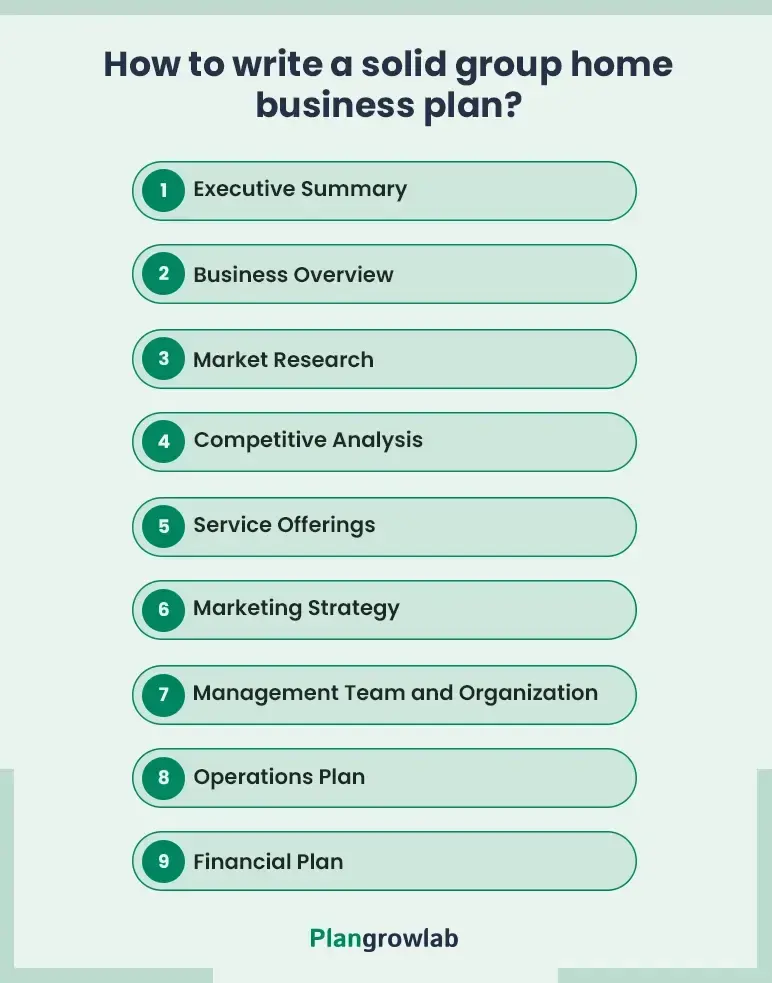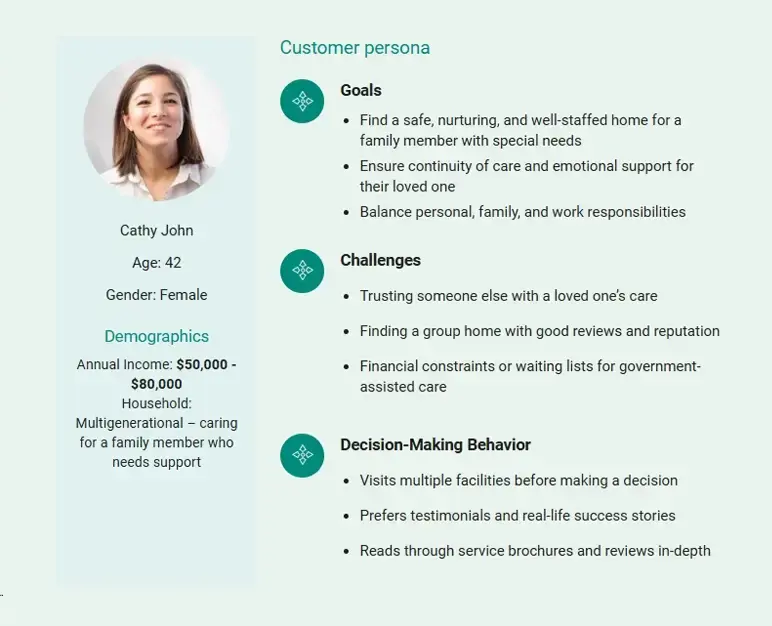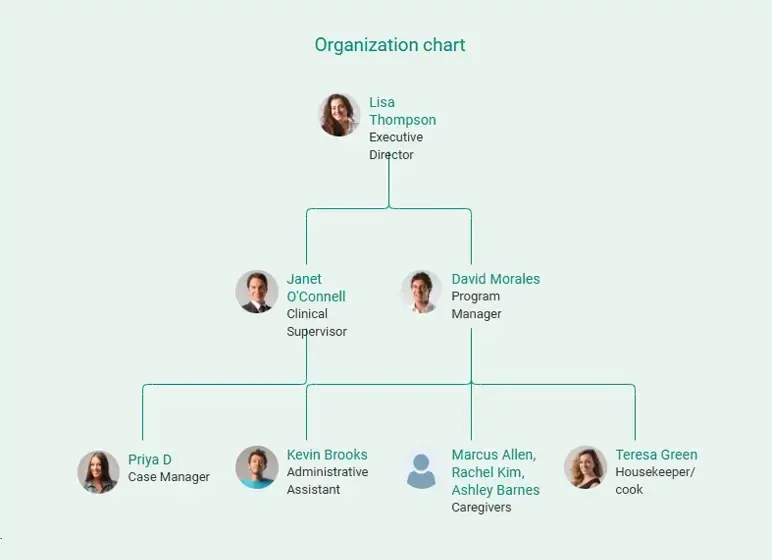Undoubtedly, there’s a growing need for safe, supportive living spaces—whether it’s for seniors, adults with disabilities, or youth in care. Group homes help meet that need, offering not just housing but real care.
Thinking of opening one? That’s a powerful step.
But writing the business plan? That’s where many people get stuck. It’s exactly what Ms. Alonda Malone experienced when she started working on her own group home business.
I recently spoke with her about how she turned her business idea into something real—what challenges came up, what she learned, and how she pushed through.
So if you’re ready to take that first step, this guide is here to help—built from real insight, not guesswork. But first...
Why a group home business plan is essential
Running a successful group home business is a big responsibility. You’re not just opening a care facility—you’re building something that affects real lives. That’s why a business plan isn’t just helpful—it’s necessary.
Here’s what a solid business plan for a group home does for you:
- It lays out your goals, your services, and how you plan to get things done.
- Licensing authorities often ask for a detailed plan to see if you’re prepared to run a safe and stable group home.
- Whether you’re applying for grants, loans, or securing funding, a plan shows you’re serious and ready to manage money responsibly.
- It helps you understand startup costs, operating expenses, and how your group home will stay financially healthy.
- From staffing to daily routines, it shows how your group home business will operate smoothly.
- A good plan doesn’t just cover launch—it helps you think about long-term success and how to improve and expand your services.
In short, a business plan is your foundation. It helps others believe in your vision and keeps you grounded as you bring it to life.
How to write a solid group home business plan?
A well-crafted business plan helps you turn your ideas into action. It shows others—like investors, partners, or lenders—that you have a clear vision and a solid strategy.
Here’s a beginner-friendly outline to guide you through the process of drafting your business plan:

1. Executive Summary
The executive summary is a one-page overview of your business. Think of it as your elevator pitch—but in written format. It should be short, clear, and answer the big questions: what your group home does, who it serves, why it matters, and how it will run.
What to include:
- The business name of your group home and its legal structure (LLC, nonprofit, etc.)
- Location and target market (e.g., seniors with Alzheimer’s, seeking mental health support, adults with disabilities)
- A quick overview of the services you provide
- Brief summary of your business goals and why you started
- Key financial facts (startup costs, personal savings, funding needs, expected revenue)
- A summary of your team or background
"When I was working on the executive summary for my group home business, I kept second-guessing myself. I thought—how do I put the heart of this group home business into just one page?
But once I got clear on who we were helping and why it mattered, the rest followed. I wrote about the kind of care we’d provide, what made us different, and how we’d actually make it work—day-to-day and financially.
That section turned out to be more than a summary. It reminded me of my purpose and gave structure to everything else I planned." —Ms. Alonda Malone
2. Business Overview
This section gives a quick but clear look at your group home business—what you do, who you help, and why your work matters. It’s the part of your plan that helps people like investors, licensing agencies, financial forecasts, and future partners really understand what drives your business.
Make sure to include these important details:
- Business legal structure (sole proprietorship, partnership, LLC, or nonprofit)
- Vision and mission statement
- Core values (compassion, safety, dignity, or respect)
- Business history
- Short-term and long-term goals
Keep it simple and real with all the basic information about your group home. This section should show why your group home matters and how you plan to make a real difference.
"I didn’t come from a business background, so writing the overview felt intimidating at first. But I just started with what I knew—who we serve, what kind of regulatory environment I wanted to create, and why it mattered to me.
I’ve always believed that stability, dignity, and structure can change someone’s life. That belief became the backbone of our group home company. Once I put that into words, the business part started making sense. It wasn’t just about services—it was about creating a place where people felt human again." —Ms. Alonda Malone
3. Market Research
Before starting a group home business, it’s important to understand who really needs your services, what’s already out there, and where the gaps are. This section helps show that your group home company isn’t just thoughtful—it’s actually needed.
The following questions should be answered in this section of your group home business:
Who you’re serving
Describe the people your group home is meant for. Are you helping seniors, adults with disabilities, teens in foster care, individuals with complex medical histories, or another group home business? Share a bit about their needs and how many people in your area fall into that category.
Why there’s a need
Back it up with facts or local market examples. Maybe there aren’t enough homes nearby. Maybe waitlists are too long. Or maybe families are struggling to find quality care that’s close and affordable.
What’s missing
Think about what other homes don’t offer. Is there a lack of one-on-one support? Are the facilities outdated or too expensive? This helps you explain how your group home services will fill the gap.
Who else is out there
Talk about a few other group homes in your area. What do they do well? Where do they fall short? This shows you understand the local landscape and have a plan to stand out.
Market trends
If there are any shifts in the group home industry—like a move toward smaller, more home-like environments or more personalized care—mention those too.

"I used to think caring was enough. But when I started looking into market trends, I realized how much I didn’t know. I had to understand licensing, zoning, how many homes were already out there, and what gaps existed.
It wasn’t just numbers—it was stories. I talked to social workers, nurses, and even family members of folks who had been in physical health care. That’s when it clicked: our group home business had to meet real needs, not just good intentions.” —Ms. Alonda Malone
4. Competitive Analysis
Before opening your group home, it’s a good idea to see what other places around you are doing. This helps you figure out what makes your business different—and better.
Start by looking at the nearby group homes and their business history. Where are they located? What do they charge? What kind of play areas do they have? Compare their setup with yours, and think about what gives you an edge.
Pay attention to pricing, too. Are they more budget-friendly, or do they charge premium rates? How do they reach customers? Are they active on social media, or do they show up at local events?
To take it a step further, do a quick SWOT analysis—list your Strengths, Weaknesses, Opportunities, and Threats.

When you really understand your competition, you’re in a better spot to build something families will keep coming back to.
"Looking at other group homes was eye-opening. At first, I felt discouraged—some had years of experience and more community resources. But once I really looked, I saw gaps.
Some felt too clinical. Others lacked structure or community connection. That’s where we stood out—with warmth, clear routines, and strong local ties.
The goal wasn’t to compete—it was to find our space to do something meaningful." —Ms. Alonda Malone
5. Service Offerings
This part of the plan breaks down what your group home offers on a daily basis. It’s not just about meeting basic needs—it’s about creating a stable, supportive environment where residents can grow. These services show how your team will care for people, help them build life skills, and support their emotional well-being.
Here’s how you can break down the different services for your group home company:
| Service | Description | Why It Matters |
|---|---|---|
| 24/7 Supervision & Support | Staff available all day and night to give care and structure. | Residents stay safe and supported at all times. |
| Medication Management | Staff give meds as prescribed and keep detailed records. | Helps avoid mistakes and ensures proper treatment. |
| ADL Support | Help with bathing, eating, dressing, and moving around. | Supports dignity and everyday independence. |
| Individualized Care Plans | Each resident has a personal plan based on needs and goals. | Keeps care focused and meaningful for every individual. |
| Mental Health Support | Staff provide emotional support or connect with professionals. | Helps residents stay stable and manage mental health. |
| Therapy (Group & Individual) | Weekly sessions led by licensed counselors or therapists. | Builds trust, reflection, and emotional strength. |
| Case Coordination | Staff handle paperwork, benefits, and outside appointments. | Makes sure care is organized and nothing gets missed. |
| Life & Job Skills Training | Teaching basic tasks like cooking, cleaning, and job prep. | Prepares residents for more independent living. |
| Community Activities | Social outings, group events, or volunteer opportunities. | Helps build confidence and feel part of the community. |
The goal is to clearly show what makes your group home a safe and family-friendly space.
"When I started outlining our services, I kept wondering—how do you list compassion? It’s more than meals and meds. It’s showing up, especially on the hard days.
Writing it out helped me focus: on personal care, life skills, appointments, and emotional support. And I made sure to include the little things that matter—birthday dinners, laughter, and trust. That’s what people remember." —Ms. Alonda Malone
6. Marketing Strategy
Getting families in the door takes more than just opening up—you need a marketing strategy to reach them and have strong customer retention strategies.
Start by focusing on online visibility where you can find your ideal target market. Social media platforms like Instagram and Facebook are perfect for showing off your space, announcing events, and sharing fun moments.
Make sure your group home is easy to find online. A clean, mobile-friendly website with clear photos, prices, and location info is a must.
Offline efforts still work, too. You can print flyers and place them in schools, cafés, and libraries where families hang out. Small ads in community newsletters or local parenting magazines can also help to reach your target market.
"Having a marketing plan felt strange at first. I wasn’t trying to sell a product—I was trying to build trust. That meant showing people who we are, not just what we do.
I focused on building real relationships. I connected with caseworkers, went to community events, and made sure our materials spoke in plain language. Not buzzwords—just honesty and clarity. This really helped mw to build a strong marketing strategy.
Word of mouth was powerful too. Families who had good experiences told others. That kind of trust can’t be bought, but you have to earn it every day."
—Ms. Alonda Malone
7. Management Team and Organization
The management team section introduces who’s running the business and how it’s set up.
Start by naming the group home business founders or key managers. Include a brief note on their background—especially any experience in childcare, business, or customer service.
If there are partners, explain who does what. For example, one might handle daily business operations while another focuses on finances or marketing strategy.
Mention your staffing plans, too. List the roles you’ll need (like supervisors, front desk, or cleaners) and any required training—especially around safety and first aid.
Finally, describe your team structure. A sample of group home team structure:

Keep it simple—who reports to whom and how the group home business will be managed day-to-day. This helps your group home business to run things smoothly.
"At first, I tried to do everything myself—intake, cooking, paperwork, the whole thing. But I burned out fast. That’s when I realized: that a group home business isn’t just about one person’s vision. It takes a team.
I started bringing in people who believed in the mission and had the right mindset. Not just resumes, but heart. Folks who understood structure, patience, and the day-to-day challenges.
Building the team and defining everyone’s role gave the home its rhythm. That structure didn’t just help us—it made things more stable to foster care group home for the people we care for." —Ms. Alonda Malone
8. Operations Plan
The operational plan explains how your group home business will run on a daily basis.
Start with your hours of business operations—what days and times you’ll be open. Then, talk about how you’ll manage daily tasks like cleaning, safety checks, mealtime, and supervising the customers.
Include how many staff members you’ll have per shift and what their responsibilities will be. Mention how you’ll handle busy times such as mealtime rush, bedtime, cleaning time, etc.
Also, explain how you’ll keep the space safe and clean—like regular equipment checks, sanitizing routines, and emergency procedures. Do try to follow the health and safety standards and procure your medicines with an established service provider.
The goal is to show that you have a simple, organized plan for efficiently managing and running your group home business.
"Writing the business operations plan forced me to think through the boring—but crucial—details. Who opens the group home in the morning? Who handles medication management? What happens during an emergency?
In this kind of work, routine is everything. People need consistency to feel safe. So I built a schedule that balanced structure with flexibility. Staff shifts, meal prep, cleaning checklists, daily notes—it all had to run like clockwork.
Once my group home business plan was in place, I could breathe a little. It gave everyone—staff and residents—a sense of rhythm and trust in how the home runs." —Ms. Alonda Malone
9. Financial Plan
This part explains how your group home will make money and cover its costs. It’s also what investors will look at to see if your business can succeed.
Include a few key things:
- Income statement
- Cash flow statements
- Break-even point
- Balance sheet
- Startup costs
- Funding plan
- Risk plan
Also, include financial projections for the next 3–5 years and explain how you plan to grow.
"This was the hardest part for me. I didn’t grow up talking about budgets or cash flow. But running a group home means your heart and your books both have to be in order.
I had to learn how to plan for staff pay, supplies, food, and licensing fees—and also leave room for the unexpected. One missed number can throw everything off.
Once I put the financial highlights together, it gave me more than just numbers. It gave me peace of mind. I could finally see how this wasn’t just a dream—it could actually sustain itself." —Ms. Alonda Malone
Download a free group home business plan template
Ready to create your group home business plan? Not sure where to start or what to include? We’ve got you covered.
Download our free group home business plan pdf to get started. It includes real examples, simple tips, and a clear layout to help you write a plan that fits your vision and meets licensing or funding needs.
Summary
With the help of this guide and template, putting together your group home business plan should feel more straightforward.
Still have questions or want to make sure everything’s done right? Our team can help. Our business plan consultant will work with care-focused businesses like yours to guide you through building a strong, clear plan that meets your goals.
Need support? Reach out for a quote—we’re here when you need us.
Frequently Asked Questions
How can I differentiate my group home services?
Focus on the quality of care, staff-to-resident ratio, specialized programs, unique residential facilities, compulsory mental health support, or a unique approach to support (like trauma-informed care or family-style living). Think about what matters most to the people you serve—and do that better than others. By doing so, you can have a successful group home business.
What are the key elements of a detailed financial plan?
Here are the main financial projections to include in your group home business plan:
- Startup costs
- Monthly operating expenses
- Revenue projections
- Income statement
- Cash flow statement
- Balance sheet
- Break-even analysis
- Funding needs
- Risk plan
Having all of this in your plan shows that you're ready to run your business like a veteran group home—prepared, responsible, and ready for growth.
Why do you need to conduct market analysis?
Market analysis helps you understand the demand for your group home services, who your competitors are, what gaps exist, and how you can offer something better or different. It also shows funders and licensing agencies that your plan is based on real needs—not guesses.
How long does it take to complete a group home business plan?
It depends on how prepared you are with the details of your group home. With a clear idea and the right tools, you can write a strong draft in a few days. If you’re starting from scratch or need research, expect it to take a couple of weeks.
Is it worth hiring business plan consultants or writers?
If you’re stuck, short on time, or need a group home business plan for funding or licensing, hiring a professional can save you stress and help you avoid costly mistakes. A good consultant will help you stay clear, focused, and on track.

